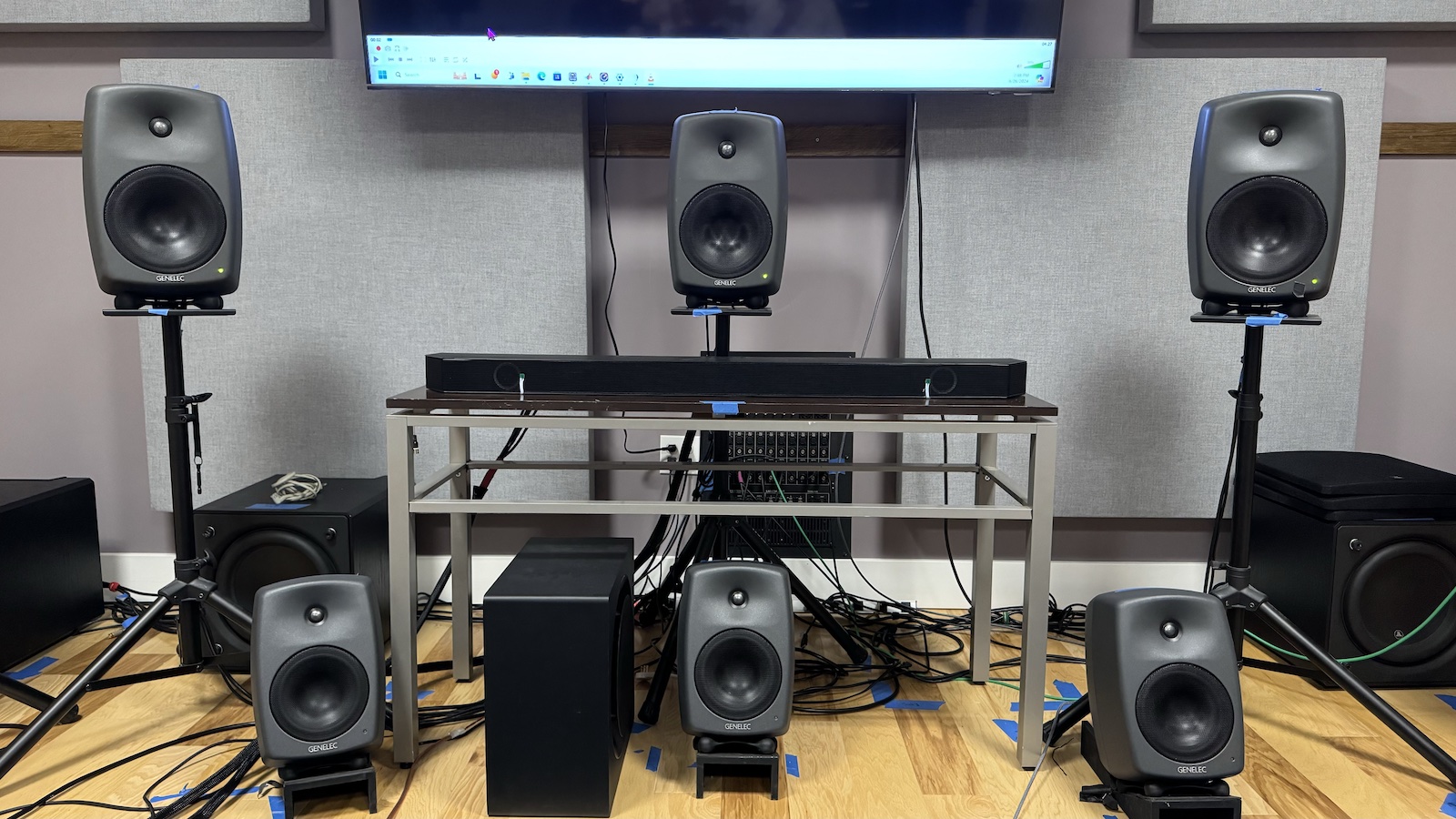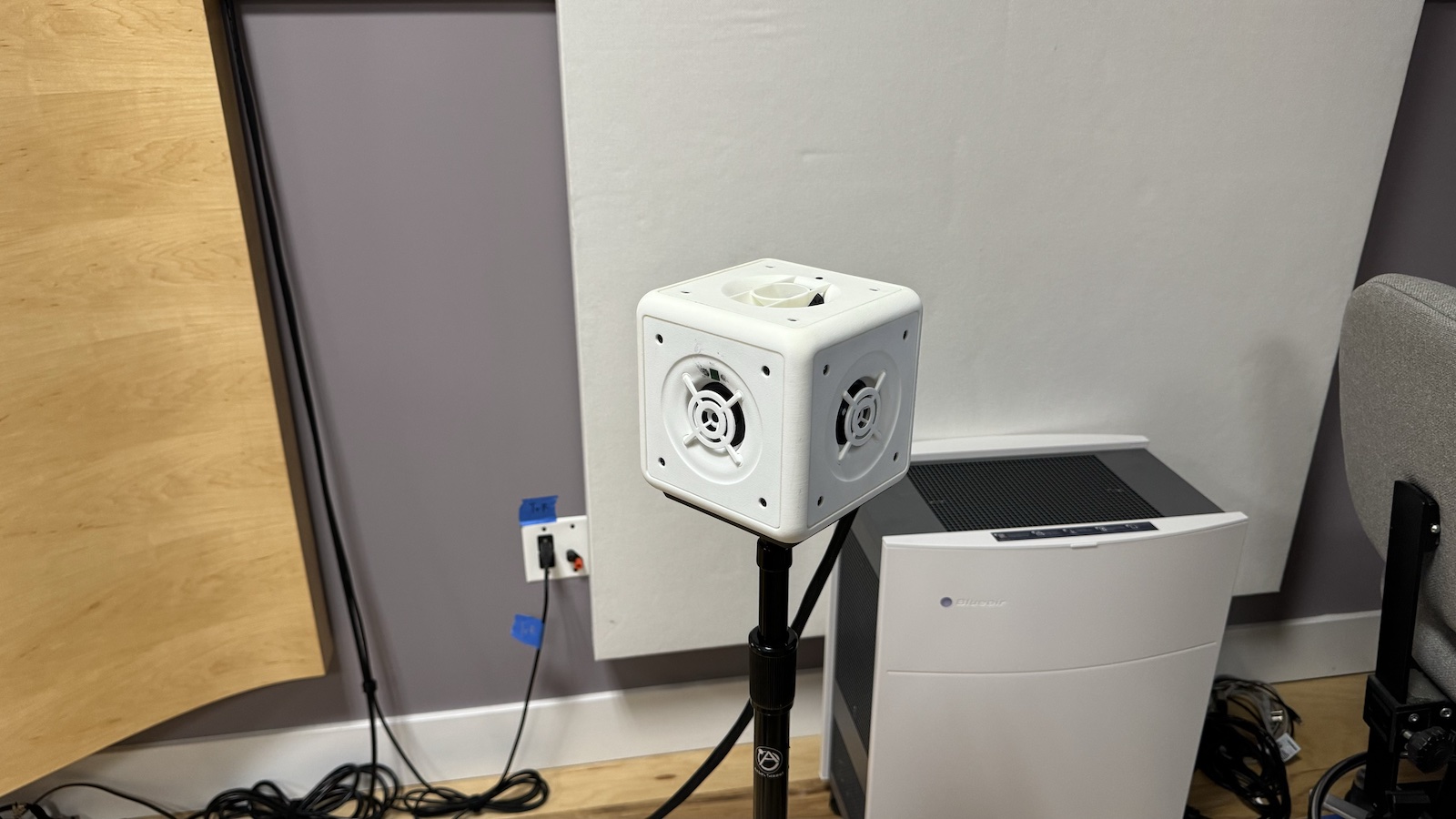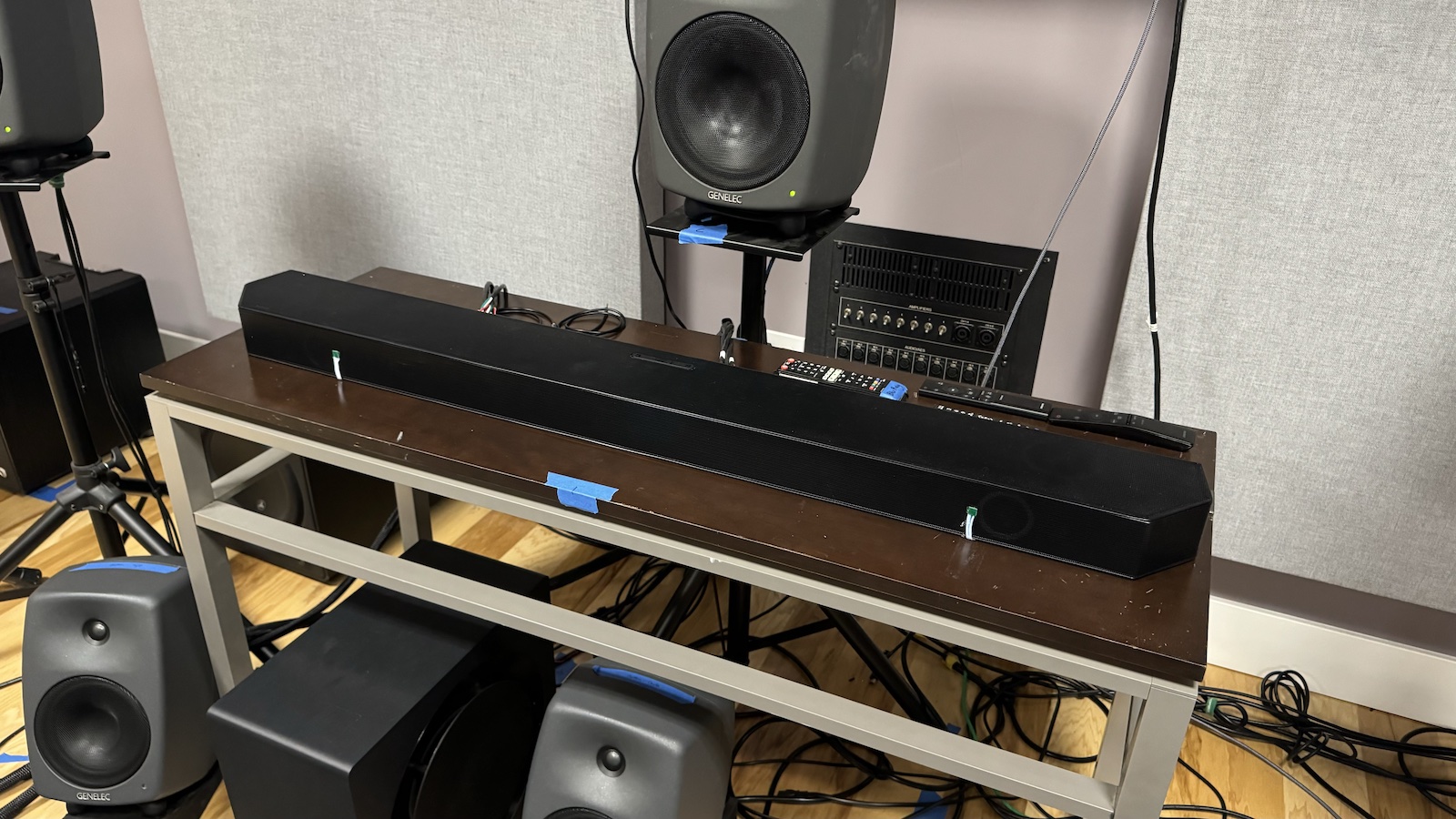
I was recently treated to a highly exclusive tour of Samsung’s Audio Lab in California. This is where many of the brand’s audio products – from wireless speakers and soundbars to the sound systems of its TVs – are tuned, and also where a huge amount of research is conducted into the future of home audio. I speak from experience when I say that it’s run and staffed by some of the brightest and most music-obsessed people I’ve ever met, and in each room we entered I was introduced to yet more brilliant engineers and intriguing technology.
The room I’m most concerned with here is one that was packed with Genelec studio monitor speakers. I regret to say that I didn’t count the number of speakers in the room but, looking back at my photos I can see that there were 10 across the front – five at seated ear-height, two mounted in a row above and three on the floor. I think there was a similar quantity of speakers behind and to the sides of the seating position, so we’re talking about a system consisting of roughly twenty speakers. And that’s not including subwoofers, of which there were four across the front. I’ve been in lots of speaker-filled rooms in my time, but this one took the biscuit.
Why does the Samsung Audio Lab have a system consisting of 20+ Genelec speakers? Primarily because it’s working on the IAMF royalty-free immersive audio format to rival Dolby Atmos – something that we’ve written about before and that also involves Google. So, after a very interesting precis of IAMF from Samsung’s Allan Devantier, his colleague Eduardo Rubio fired up Bailando by Enrique Iglesias in Dolby Atmos.
I was immediately struck by the spaciousness of the presentation. A seamless, three-dimensional soundstage filled the room and I could hear voices and instruments all around me. In fact, the presentation sounded larger than the room in which we were sitting. There was a lovely tonality, too, with the bass and midrange interlocking just as they should and the treble sounding clear and detailed without any brightness. Bailando isn’t my kind of track, but it was impossible not to be impressed by the delivery.
As the music faded out, Devantier spoke: “So, nice sense of envelopment, nice sense of space – but are you 100 per cent sure you know what you were listening to?
“You were listening to the soundbar. You were listening to the soundbar and those surround speakers – those studio monitors – were not on."
Then the penny dropped – the chat about IAMF and the room full of speakers were part of a ruse and what we were listening to was a prototype Q990 soundbar system.
Cutting-edge prototypes

Before I go on, I need to get a couple of disclaimers out of the way. The first is that this really is prototype kit. The main soundbar unit was clearly a Frankensteined version of the one in the Q990D package with lots of unfinished elements, and the cuboid rears had been manufactured on-site in bare white plastic. The subwoofer, too, simply looked like one from the Q990D package, though who knows what the internals were like. In other words, the final speakers will likely look nothing like what you see in the photos here. They may not sound like what I heard, either. Devantier and his team work very much at the cutting edge of product development, producing concepts that Samsung may or may not use. Devantier says, “I think you’re gonna see some of the fruits of that research in 2025 soundbars,” but it’s clear that some of this work could bleed into 2026 or perhaps never see the light of day at all.
The other big disclaimer is that I’m not allowed to tell you about the technology being used. I can tell you that there is new technology involved, which means this is far more than just an evolution of the existing Q990 range, and I can tell you what it sounded like, but I can’t be more specific than that as Samsung quite understandably doesn’t want to show its hand to its rivals.
With all of that out of the way, we can get back to the sound. Demo two was one of Dolby’s own Atmos samplers, which I have heard about a million times before. In fact, I’ve heard it (fairly recently) on the Q990D, and it certainly sounded better here. The Q990D is by soundbar standards an extremely impressive deliverer of Dolby Atmos, in that it doesn’t simply deliver height as many rivals do – it also places sounds in pretty precise locations in three-dimensional space, which is what Atmos is really about. From time to time, though, you can still hear the speaker rather than the sound effect, and there are small parts of the soundstage in which those precise effects seemingly cannot be placed.
The new technology in the prototype soundbar package is designed to address those things, and in this second demo the improvements were clear. At no point was my ear drawn to a specific speaker. It was instead drawn to the specific sounds as they appeared in the space. Those sounds moved around the presentation from side to side and up and down with no gaps being revealed in the soundstage. Many Dolby Atmos soundbars deliver sound in two or three vertical layers, but here there’s fluidity to the verticality, which makes everything sound more natural.
Benefits to stereo music, too

Interestingly, this new technology can also be used to overcome the size limitations of the soundbar and produce a wider and more effective stereo presentation without adding what Devantier refers to as the “colourations” usually associated with sound-widening effects. The goal, he said, is to produce stereo sound that is “colouration-free and really wide”. With that, Rubio fired up Everybody Plays The Fool by soul singer Aaron Neville, during which he would push a button to switch between standard stereo and the new widening technology.
This was another very impressive demonstration. With the new tech enabled, the stereo image opened up dramatically, adding a real sense of spaciousness, yet the vocal focus, detail and clarity remained. To these ears, it sounded like all gain and no pain, and is as close as I’ve heard a soundbar get to delivering the experience of listening to a pair of properly positioned stereo speakers.
The final demo was the most striking, though. Rubio played a clip of an old-school BBC-style radio presenter reading from a script, with no other sounds whatsoever. The goal here was to make the sound appear to be coming not from the speakers, but from areas in the room in which there were no speakers. It wasn’t perfect – at times I could hear the soundbar almost tugging at the voice slightly – but it was overall very effective indeed. Devantier and Rubio knew it wouldn’t sound perfect, but they wanted to demonstrate the new technology in its most exposed form. As Devantier says, “When you start having all 12 channels going, and there's people dancing, and there's music, and there's this and that, the illusion gets more realistic… put on a sexy video, all of a sudden it sounds really, really, really freaking cool.”
While I might not agree with him on the coolness of Enrique Iglesias’ Bailando (though, frankly, who am I to talk?), there’s no denying that the soundbar technology that he and his team are working on seems very cool indeed. And, given that Samsung is already the best in the business when it comes to Dolby Atmos soundbar packages, that should have its rivals very worried indeed.
MORE:
Read our review of the current Samsung Q990D
These are the best Dolby Atmos soundbars you can buy right now
And here are the best Dolby Atmos scenes for testing your system







